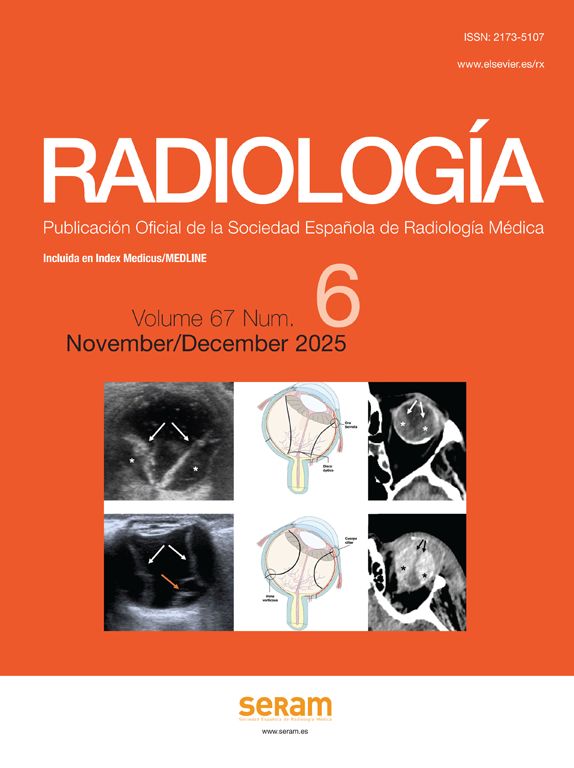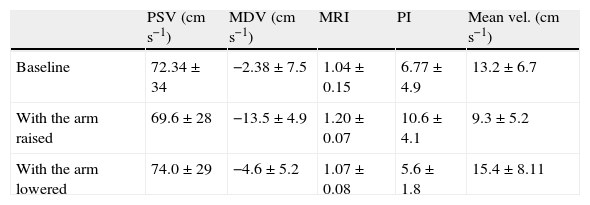Holodiastolic arterial blood flow is associated with pathological conditions. Nevertheless, we have observed that lifting the arm at an angle greater than the horizontal causes holodiastolic arterial blood flow in the brachial artery in normal patients. Thus, we decided to assess the frequency and characteristics of this phenomenon.
Material and methodsTen volunteers (7 women) aged 43±17years participated in the study. We used an ultrasound scanner with a 12MHz probe to analyze the brachial artery. The examination included: (a) baseline measurements in the supine position; (b) measurements during 3min with the arm raised; and (c) a measurement 60s after lowering the arm to the supine position in which the baseline measurements had been obtained.
ResultsWe observed mid- and end-diastolic retrograde flow in 8/10 patients when their arms were raised. No mid- or end-diastolic retrograde flow was observed in the baseline measurements or after the arm was lowered to the supine position (p=0.0007). The minimum diastolic velocity was significantly higher in the measurements obtained with the arm raised than in the supine position before or after arm raising (−13.5±4.9cm/s vs −2.38±7.5cm/s, p<0.05 and −13.5±4.9cm/s vs −4.6±5.2cm/s, p<0.05, respectively). The modified resistance index was significantly higher when the arm was raised (1.20±0.07 vs 1.04±0.15; p<0.05); moreover, the modified resistance index was significantly lower in the measurements obtained after the arm was lowered than in the baseline measurements (1.20±0.07 vs 1.07±0.08; p<0.05).
ConclusionWe conclude that holodiastolic reflux occurs in healthy patients. This physiological phenomenon merits further investigation and can help elucidate previous observations in different pathological conditions.
La existencia de flujo sanguíneo arterial retrógrado holodiastólico es un fenómeno asociado a condiciones patológicas. Sin embargo, hemos observado que en pacientes sanos, la elevación del brazo por encima de la horizontal produce flujo de estas características en la arteria braquial. Por lo tanto, decidimos evaluar la frecuencia y características de dicho fenómeno.
Material y métodosDiez voluntarios (7 mujeres) con una edad de 43±17 años participaron del estudio. El análisis de la arteria braquial fue realizado utilizando un equipo de ultrasonido con transductor de 12MHz. El estudio incluyó: a) mediciones basales en posición supina; b) una evaluación de 3 minutos con el brazo elevado, y c) una medición a los sesenta segundos después de bajar el brazo a la posición supina en la cual fueron realizadas las mediciones basales.
ResultadosSe encontró flujo retrógrado meso y telediastólico en 8/10 pacientes durante la elevación del brazo. En las mediciones basales y post-elevación ningún paciente presentó reflujo meso o telediastólico (p=0,0007). La velocidad mínima diastólica se incrementó significativamente durante las mediciones con el brazo elevado en comparación con aquellas basales y post-elevación (−13,5±4,9cm/s frente a −2,38±7,5cm/s; p<0,05 y −13,5±4,9cm/s frente a −4,6±5,2cm/s; respectivamente; p<0,05). El índice de resistencia modificado presentó un aumento significativo durante la elevación del brazo (1,20±0,07 frente a 1,04±0,15; p<0,05) y un descenso significativo en las mediciones post-elevación comparado con aquellas basales (1,20±0,07 frente a 1,07±0,08; p<0,05).
ConclusiónConcluimos que el reflujo holodiastólico está presente en pacientes sanos. La comunicación de este nuevo fenómeno fisiológico fomenta futuras investigaciones y podría ayudar a comprender observaciones previas en distintos estados patológicos.







